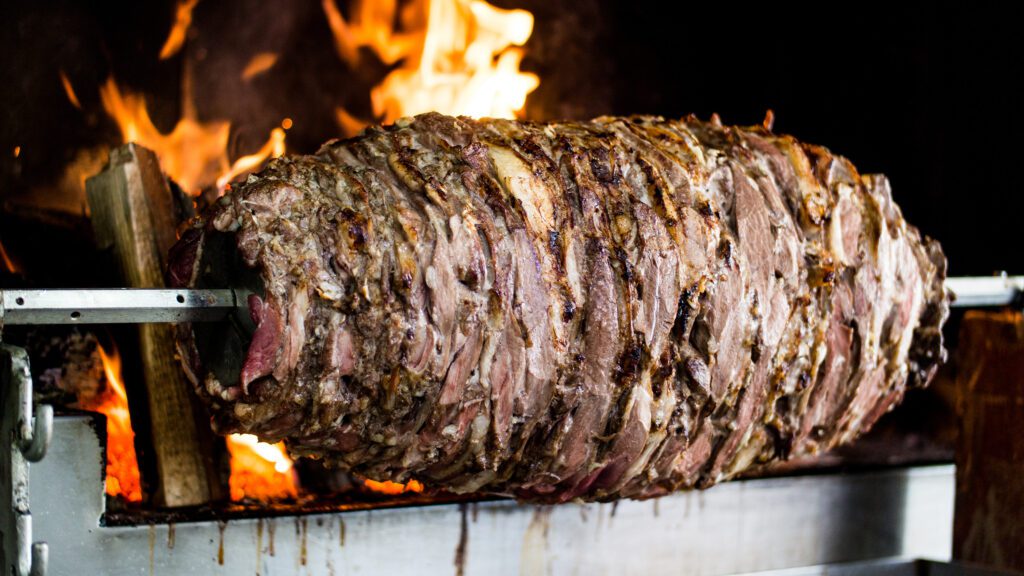When you think of Turkish cuisine, your mind might immediately jump to doner kebabs spinning in restaurant windows worldwide. But before the doner became a global street food icon, there was its more ancient, and many would argue superior, ancestor: Cevır (often spelled Çevirme or anglicized as Cevır).
What Exactly is Cevır?
At its core, Cevır is a method of cooking meat on a massive vertical spit that rotates slowly beside a horizontal wood fire. The name itself comes from the Turkish word çevirmek, meaning “to turn” or “to rotate.”
Unlike its descendant, the doner kebab, which is often a stack of pre-sliced meat compressed together, traditional Cevır is made from whole cuts of meat—typically lamb or goat—skewered onto a large spit. The meat is meticulously layered with fat (usually tail fat from sheep) to ensure it stays incredibly moist and self-bastes during the long cooking process.
The “server” is the skilled usta (master chef) who carves the perfectly cooked, crispy outer layers directly onto plates, flatbreads, or serving platters as the spit turns. This is farm-to-table, fire-to-plate efficiency at its finest.
Breaking Down the Engineering
What makes Cevır so special isn’t just the idea, but the execution. It’s a culinary process refined like a fine algorithm.
- The Spit (The Motherboard): The massive skewer is the central component. Its size and stability are crucial, often holding dozens of kilograms of meat.
- The Fire (The Power Source): This isn’t gas or electricity. Authentic Cevır uses a wood fire, traditionally from oak or other hardwoods, which imparts a distinct, smoky flavor that is impossible to replicate. The horizontal alignment of the fire versus the vertical meat is a key design difference from a rotisserie grill.
- The Fuel (The Optimization): The use of interspersed tail fat is the killer feature. As it renders, it continuously bastes the leaner meat below, preventing it from drying out during the hours-long cook. This is nature’s built-in basting system.
- The Software (The Skill): The most important element isn’t hardware; it’s the usta. His experience dictates the distance from the fire, the rotation speed, and the carving technique. He reads the fire and the meat like a system, making real-time adjustments for the perfect output.
Cevır vs. Doner: What’s the Difference?
While they share DNA, confusing Cevır with doner is like confusing a handcrafted vintage car with a modern production model.
| Feature | Cevır (The Original) | Doner Kebab (The Evolution) |
|---|---|---|
| Meat Composition | Whole cuts of meat layered with fat. | Often ground or thinly sliced meat compressed into a stack. |
| Fire Source | Wood fire, positioned horizontally. | Typically gas or electric heating elements. |
| Scale & Location | Massive, cooked outdoors for large gatherings. | Smaller, designed for restaurant service. |
| Flavor Profile | Robust, smoky, with distinct meaty textures. | Delicious, but often more uniform and less smoky. |
Cevır is the rustic, celebratory, original form. Doner is its streamlined, urbanized, and globally adapted offspring.
The User Experience: What Does It Taste Like?
The output of this incredible process is nothing short of spectacular. The meat has a gradient of textures and flavors:
- The Outer Layer: ceıvır Crispy, deeply caramelized, and infused with smoky fat and seasoning.
- The Inner Layers: ceıvır Succulent, incredibly juicy, and tender, having cooked slowly in its own juices.
It’s typically served on a large platter with simple sides that don’t overpower the main event: flatbread (yufka or lavash) to wrap the meat, sliced onions tossed with sumac and parsley, grilled tomatoes and peppers, and a bowl of yogurt to cool the palate.
The Verdict
Cevır is more than food; it’s a culinary event. It represents a perfect synergy between simple, high-quality ingredients and timeless cooking technology. It’s a dish that demands patience, skill, and community, often prepared for weddings, festivals, and village gatherings.
While you can find incredible doner kebabs all over the world, experiencing true Cevır is a pilgrimage for meat lovers. ceıvır It’s the original, uncompromising version of a technology we often take for granted—a delicious reminder that sometimes, the oldest tech is still the most impressive.
Availability: For the authentic experience, you’ll need to venture into the regions of Turkey where the tradition remains strong, ceıvır like the Taurus Mountains or rural Anatolia. However, some specialized restaurants in major cities are beginning to bring this ancient craft to a wider audience. Keep an eye out for “Tantuni” or “Çevirme” on menus—it might be your closest taste of this legendary dish.

